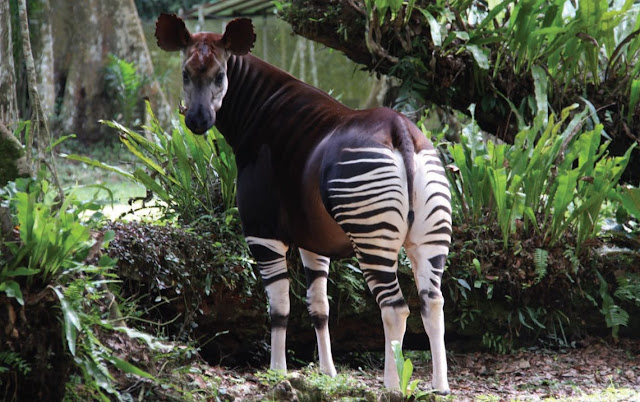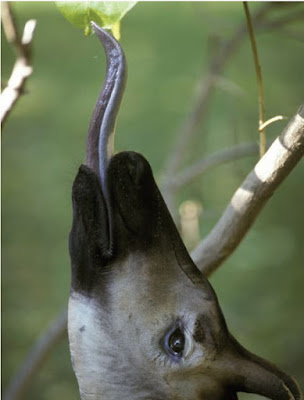FORMULATINGa conservation strategy for what is possibly the most elusive large mammal
on the planet is unquestionably a challenge: how do you save something you can’t see, count, or study in its natural habitat? John Lukas has devoted almost a quarter of a century to solving
this complex quandary.
“Okapis have evolved to perfectly blend into the forest I’ve never actually seen a wild okapi in all my years working to conserve them,” says Lukas.
Lukas is the founder of the Okapi Conservation Project (OCP), which he started in 1987. The project operates out of the Epulu Conservation and Research Center located within the Okapi Wildlife Reserve in the Democratic Republic of the Congo (DRC), where as much as one-third of the world’s wild okapi population is thought to live. In fact, okapi and leaves are the symbol of all the protected areas of the DRC, reinforcing the link between healthy forests and healthy wildlife populations.
Okapis, readily identified by their dark, velvety coats and black-and-white striped legs and hindquarters, are the only living relative of the giraffe. About the size of a large horse, the okapi was not described by scientists until the start of the twentieth century, long after most other large species had been identified and documented.
The okapi lives exclusively in the Ituri Rainforest of the DRC, considered by many to be the most biologically diverse place in Africa. In addition to the shy okapi, Ituri wildlife includes the notoriously amorous bonobo, the Congo peafowl, colobus monkeys, water chevrotains, genets, forest elephants, leopards, and the elegant striped bongo. Within the Ituri Forest, the Okapi Wildlife Reserve occupies almost fourteen thousand square kilometers (nearly eighty-seven hundred square miles) of multiple-use land, still inhabited by local villagers and two tribes of Pygmies.
“Before we came, there were no protected areas for okapi which was a surprise since they are the national symbol of the country,” says Lukas. “We successfully had the Okapi Wildlife Reserve declared in 1992, and worked with the Institute in the Congo for the Conservation of Nature the government partner charged with managing DRC’s protected areas to develop a management plan to operate the reserve.”
When Lukas founded the Okapi Conservation Project, he knew the obstacles that would lie in the way of his efforts. The DRC called Zaire when the project started has been in a state
of civil unrest and economic crisis throughout much of its history.
“There have been seven occupying armies at the conservation station since I’ve been involved with okapi conservation,” states Lukas. “We’ve managed to stay relatively safe however, by not taking a political side, and instead always cooperating with the occupiers and keeping close contact with staff in Kinshasa, the capital. Those contacts advise us on security risks and provide guidance on safe passage in and out of the forest, if needed.”
When a new occupying force takes over the conservation station, workers aligned with the occupying tribe run the station while those from opposing tribes go into hiding. Then,
when the next occupying army comes in, they may have to switch staff entirely to ensure the workers’ safety. Despite the many precautions, Lukas and his colleagues at the Reserve are
often in danger, and he personally has been shot at in his car and in planes. Relative security has been in place since the end of the war in 2004, as Epulu is quite a distance inland from the troubled eastern border with Uganda and Rwanda.
As difficult a situation as working in the DRC is, the Okapi Conservation Project has incredibly continued almost uninterrupted during the region’s regular political upheavals over the past twenty years. Lukas is rightly gratified with that record. “Even while invading armies are wreaking havoc on the forest and killing wildlife for bush meat, I’m proud to say that no one has ever harmed any of the dozen ambassador okapis that are kept at the center for educational purposes. We’ve even had local villagers step in to feed those okapis when the Pygmies working at the station were endangered by the occupying army and had to retreat to the forest.”
Principle threats to wild okapis include poaching, human encroachment, and loss of habitat. Because of this, the locals will ultimately determine the fate of the species. The assistance of the resident community can be traced to Lukas and his teams’ resolute commitment to the people living in and around the reserve. The OCP employs more
than two hundred local residents, and many of the initiatives they launch are designed to improve the lives of these people and forest people by providing them secure water sources, accessible health care, and training in sustainable agricultural practices. Additionally, they offer educational opportunities to area children to help them learn about the forest, its wildlife, and sustainable use of natural resources.
One of the OCP’s most innovative projects has been introducing alternative protein sources to native residents. As the pressure on okapi and other local wildlife from the bush meat trade have risen, Lukas and his colleagues have developed a program for new local food sources that have little impact on the surrounding environment. For example, they have supported the experimental Cane Rat Domestication Project, which breeds this indigenous species as a high-protein alternative to bush meat. Farmers receive assistance with building a breeding facility, some initial breeding stock, and training in how to produce animals for personal consumption and to sell in the markets.
While they are conducting these community outreach programs, Lukas and the OCP staff are also addressing the direct threats to the okapi. This is done through training and equipping wildlife guards for the Reserve and supporting their deployment to patrol the forest, where they work to arrest poachers and close down illegal mining and logging operations.
In addition to his impressive okapi conservation efforts, Lukas is an active leader in several other conservation arenas: He is cofounder and board member of the Wildlife Conservation Network, as well as the director of the White Oak Conservation Center in Yulee, Florida. The Center is a world-renowned facility for breeding and research of endangered species, and serves as a training, education, and strategizing epicenter for global leaders in wildlife conservation. As one might imagine, the Center also specializes in studying the biology and reproductive needs of the elusive okapi using captive breeding to learn more about a species that cannot be studied in the wild. Under Lukas’s leadership the Center has developed
the most successful captive breeding facility for okapi in the world, and has begun to unravel the mysteries of the mysterious mammal.
“We now know more about the okapi, its biology, and its reliance on the forest than we ever have,” says Lukas. “Hopefully this knowledge will help us and those people that share its habitat come up with the right mix of actions to save this incredibly unique species.”














0 comments:
Post a Comment